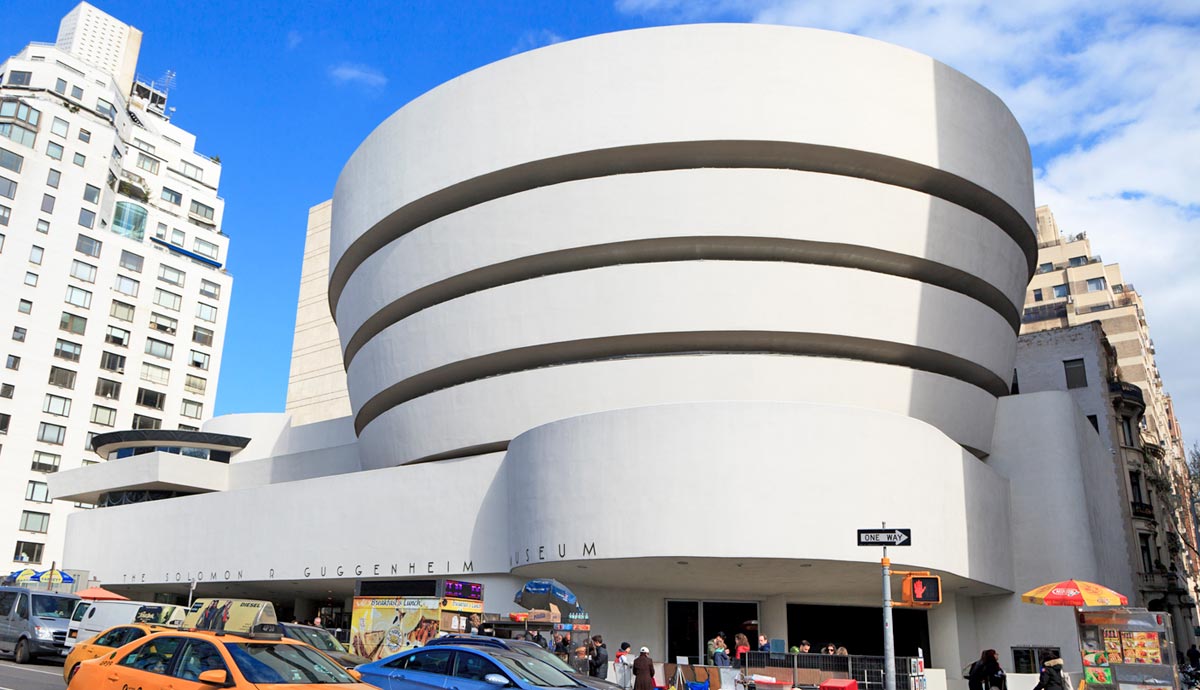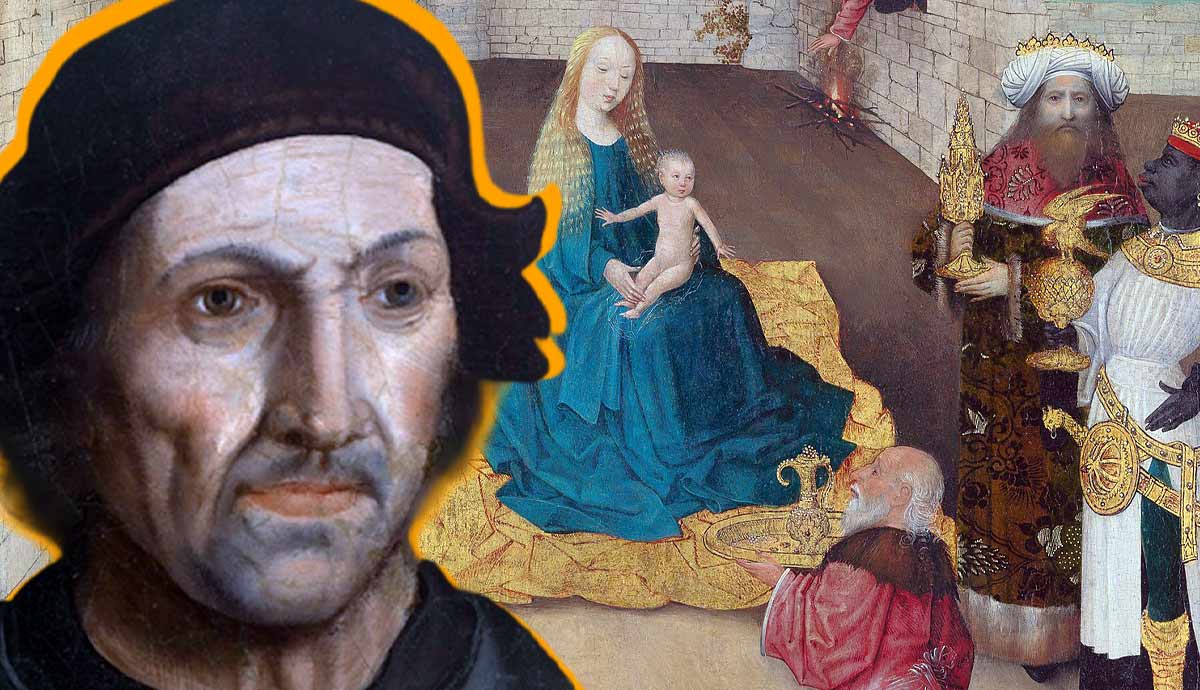
In the last century, the Guggenheim Museums have emerged and remained among the most important cultural institutions globally. The collection of extraordinary architectural designs from Frank Lloyd Wright and Frank Gehry, as well as the unique and enormous collection of modern art, attract millions of visitors every year in New York, Bilbao, and Venice. Read on to learn more about the museum’s history and the extravagant characters who made it what it is.
Solomon R. Guggenheim and the Meeting that Changed His Life

The person behind one of the most important art collections to ever exist was Solomon Robert Guggenheim—the heir of a wealthy mining family and a successful businessman of his own. He started to collect art in his forties, focusing on safe and understandable purchases of the Old Master paintings. By this time, he could afford to retire and focus all his efforts on collecting art. Initially, his interest in art was inspired by his wife Irene Rothschild, an heiress who came from a wealthy dynasty known for collecting art.
The person who changed Solomon’s outlook on the world was German Baroness Hilla von Rebay. Rebay came from an old aristocratic family, so she was exposed to exquisite art and innovative ideas from a young age. Before learning about newly emerging abstract art, she studied landscape painting and portraiture in France. During her early years, she met and befriended many modernists whom she would later promote to Guggenheim like Wassily Kandinsky, Jean Arp, Rudolf Bauer, and others. Under the guidance of Rebay, the collector would carefully pick not just any abstract painting but the most important ones of the highest quality. Guggenheim’s shift to collecting avant-garde art was partly a political move of protest. With the rise of Adolf Hitler and the attacks on Jewish artists and non-realistic art, Guggenheim, himself of Swiss-Jewish origins, decided to express his support.
Hilla von Rebay: The Artist-Curator

In her own artistic practice, Hilla von Rebay came to abstraction through Cubism, focusing on geometric forms and well-thought-out lines. She was relatively successful in Europe, but a radical change happened with her move overseas. The reason for leaving was her desire to put an end to an abusive relationship with a fellow abstract artist. Tired of violence and heartbreak, Rebay packed her paintings and left, settling in Manhattan. During her first public show abroad she sold all of her paintings and met Solomon Guggenheim.
Hilla von Rebay was eccentric with a penchant for spiritualism. She was a devout Theosophist from her early years in Paris and carried these beliefs throughout her life. She believed abstract, or non-objective art, as she called it, was not just a new movement but a new religion, a new way of communication that would replace representational art. She had a dream to build a temple for this new religion and the money and influence of Solomon Guggenheim came just in time.

Guggenheim was so impressed by this new trend in art and by Rebay’s taste that he eagerly started a collection under her guidance. In the following years, they would visit Europe together, purchasing works directly from the studios of Kandinsky, Marc Chagall, Sonia Delaunay, and many others. In 1937, they opened the Museum of Non-Objective Painting, with Hilla von Rebay appointed its director and chief curator.
Her goal was to introduce a regular American to the beauty and power of modern art, revolutionizing society. Sometimes her methods were unconventional: she burnt incense in museum spaces and conducted meditation seances. Curiously, during their first years of collaboration, Rebay begged Guggenheim to stay away from abstract art and collect safer pieces since she believed the businessman was too old to truly appreciate the language of the new world.
Although there are suspicions of their romantic connection, most historians believe it was a strong professional union built on respect and excitement about their common goal. One of the reasons for such rumors was the annoyance of Mrs. Guggenheim with Rebay’s authoritarian character and the amount of time and money her husband spent with this woman. In personal conversations, Irene Guggenheim referred to Rebay as The B, with the letter reserved for something other than Baroness.
The Legacy of Peggy Guggenheim

Solomon Guggenheim was not the only art collector in the family, and certainly not the most scandalous one. His niece, Peggy Guggenheim, achieved even wider fame and notoriety. Born into the Guggenheim family, Peggy never encountered any financial constraints, yet she was no stranger to grief and loss. At just fourteen, she lost her father when he died on the Titanic. Despite her privilege, she was never afraid of doing regular jobs. She worked in a bookstore just because she enjoyed it.
In 1920, she settled in Paris where she started her collecting journey. Peggy had a unique eye for art but not for the classic and universally-liked type. She was a trendsetter and a visionary, recognizing the potential in artists and ideas that were only gaining momentum. Marcel Duchamp was her guide through the French art world. She visited the studio of Picasso and Brancusi, partied with Romaine Brooks, and was briefly married to Max Ernst.
As World War II unfolded, Peggy fled back to New York, managing to buy a large collection of abstract and Surrealist art on her way to save them from the disasters of war and censorship. On the other side of the ocean, Peggy Guggenheim and Alfred Barr, the first director of MoMA, were among the main figures in charge of evacuating artists from Nazi-occupied Europe. Peggy’s artworks in France were endangered too, since she could not possibly bring home everything she bought. In Europe, the property of Jewish collectors was often confiscated by the Nazi authorities, with some works redistributed among German museums and Reich officials, and others destroyed or deemed degenerate. Her progressive collection of cutting-edge avant-garde was hidden in a friend’s barn outside of Paris, waiting for a safer time.

In New York, Peggy wasted no time arranging shows of refugee artists and promoting the bold American Abstract Expressionist scene. She befriended Piet Mondrian and commissioned pieces directly from Jackson Pollock. Curiously, her relationship with her uncle and his personal curator remained strained. Hilla Rebay often stated that Peggy Guggenheim collected worthless pieces of trash out of extravagance and blamed her for dishonoring the family name. In New York, Peggy opened a museum called The Art of This Century, a direct competitor of her uncle’s Museum of Non-Objective Painting.
Nonetheless, Europe was her favorite place to live and work, so as the war came to an end, she settled in Italy, once again revealing her collection to the world. To house her treasures, she purchased an unfinished palazzo in Venice. The building’s reputation was already tarnished since its previous owner was the infamous Marchesa Luisa Casati, another eccentric art collector. To this day, the building remains a museum of Peggy Guggenheim’s lifelong commitment to art and it is a part of the Guggenheim Museums family.
The Building in New York

The iconic building of the Guggenheim Museum was not always there and was a relatively late addition to the collection. Initially, Guggenheim presented his collection in a hotel suite he owned. Later on, as he and Rebay established the Museum of Non-Objective Painting, it was on display in a converted garage in midtown Manhattan. According to Rebay’s curatorial concept, the paintings were hung lower than normal. Visitors were not supposed to walk around but sit on plush benches. Such an angle, in Rebay’s view, could bring the audiences into personal, intimate contact with art and create an emotional bond with previously unfamiliar genres and styles.

By the 1940s, Rebay and Guggenheim realized that the growing collection needed a permanent home tailored to its needs and nuances. Rebay, still eager to build her temple of non-objective art, contacted the 76-year-old architect Frank Lloyd Wright. Wright’s concept was to introduce organic structures into an urban environment and create a space entirely different from the traditional notion of museums. The spiral structure with no angles or ladders was supposed to facilitate the ascension without distraction from art. The architect was inspired by the concept of ancient Mesopotamian pyramidal tombs, which spiraled downwards towards the burial chamber. To reverse the movement, aiming for life and light instead of death and darkness, Wright overturned the pyramid.
The Familiar Face of the Guggenheim Museum

Have you noticed that we have yet to mention the Guggenheim Museum? That is because it was renamed only after the death of Solomon R. Guggenheim in 1949. The building was still in construction when the events of World War II affected the availability of supplies and materials. Wright’s project was highly controversial among the museum trustees, but Hilla von Rebay managed to convince them. After Guggenheim died, the remaining family members fired Hilla and did not invite her to the 1959 opening. She never set foot in the museum again, despite many of those involved claiming the museum should have been given her name. Frank Lloyd Wright never got a chance to see his finished project, passing away half a year before the opening.

Today, the collection of Guggenheim museums includes the Wright building in New York, the Peggy Guggenheim Collection in Venice, the Guggenheim Bilbao in Spain, and a museum in Abu Dhabi currently in construction. The iconic Solomon R. Guggenheim Museum in New York remains one of the leading cultural institutions globally and has become an iconic symbol of New York City.
Hilla Rebay’s dream of building a spiral temple of art received new meaning and manifestation in 2018. That year, a now-legendary show of the forgotten abstract artist Hilma af Klint shook the art world and affected cultural trends for years to come. In her diaries, Hilma af Klint wrote about her plan to build a spiral temple dedicated to the spiritual evolution of humankind. Thus, the ideas of two abstract artists and two women who never knew each other matched for a brief moment.









